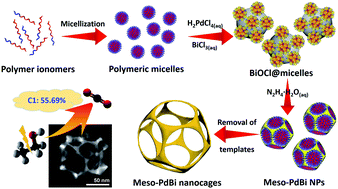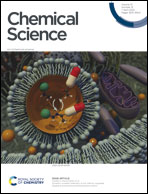Mesoporous PdBi nanocages for enhanced electrocatalytic performances by all-direction accessibility and steric site activation†
Abstract
An effective yet simple approach was developed to synthesize mesoporous PdBi nanocages for electrochemical applications. This technique relies on the subtle utilization of the hydrolysis of a metal salt to generate precipitate cores in situ as templates for navigating the growth of mesoporous shells with the assistance of polymeric micelles. The mesoporous PdBi nanocages are then obtained by excavating vulnerable cores and regulating the crystals of mesoporous metallic skeletons. The resultant mesoporous PdBi nanocages exhibited excellent electrocatalytic performance toward the ethanol oxidation reaction with a mass activity of 3.56 A mg−1_Pd, specific activity of 17.82 mA cm−2 and faradaic efficiency of up to 55.69% for C1 products.

- This article is part of the themed collection: Most popular 2022 materials and energy articles


 Please wait while we load your content...
Please wait while we load your content...